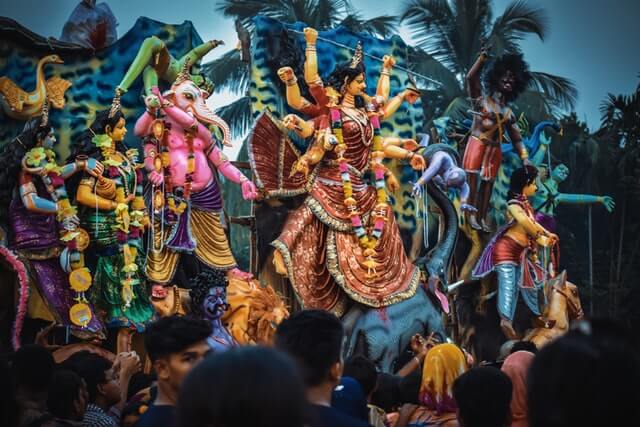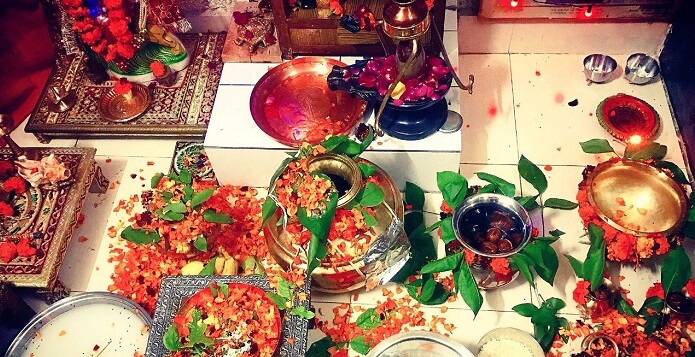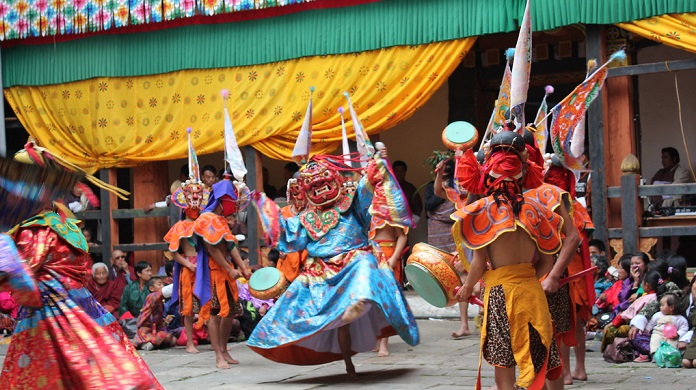Jammu and Kashmir is a culturally diverse state with three different regions in the erstwhile state of Jammu and Kashmir.
The festivals of Jammu and Kashmir can be understood on the basis of three regions - Jammu, Kashmir and Ladakh.
On the other hand, some festivals are celebrated mainly in Northern India while some are celebrated mainly in Jammu and Kashmir but partially in India.
On the day of Lohri, children go door-to-door in the neighbourhood to ask for Lohri (which is the mixture of peanuts and other eatables) by singing songs in the local dialects.
2. Baisakhi or Basoa
Baisakhi (Basoa regionally) is a harvest festival of Jammu and Kashmir celebrated in the month of April and one of the major festival in Jammu region.
Various fairs and Dangals are organised on the auspicious day of Baisakhi from 13 April to 15 April every year.
In Jammu, 13 April is also celebrated as General Zorawar Singh Day. It is a regimental day.
General Zorawar Singh was the Stalwart General of Dogra Regiment who conquered Ladakh under the leadership of Maharaja of the erstwhile state of Jammu and Kashmir.
3. Navratri Festival
Navratri is indeed the festival of Jammu. Jammu and Kashmir is the holy abode of Shri Mata Vaishno Devi and in the Navratri, the Darbar of
Mata Vaishno Devi is decorated as no less of a Heaven.
Navratri festival is celebrated every year in the month of October for 9 days.
However, the Navratris are celebrated twice in a year but the Navratris in the month of October with the Ramnavmi is mainly celebrated in Jammu and Kashmir.
People also practice fasting in the holy days of Navratris, usually on the first and last Navratri.
At the 9th and the last day of Navratri people practice Kanjak Pujan (worship of Girls).
Literally, on this day people on the streets of Jammu city are waiting for the girls in order to observe the Kanjak Pujan ritual.
The Navratri festival celebrated for a total of 9 days has major importance among the people of Jammu.
On this day people organise Jagrans (locally known as Jagratas) in the homes and in the streets of Jammu which last for the whole night.
A grand Mela/Fair and Jagran is also organised annually in
Bahu fort Temple of Jammu.
4. Janmashtami (Kite festival)
Janamashtmi: the birthday of Lord Krishna.
As Janamashtmi is the major festival of Hindu religion celebrated in the month of August, it is also one of the major festivals of the Hindus of Jammu and Kashmir.
In the pious day of Krishna Janmashtmi, elders practice fasting while the children enjoy flying kites.
If the weather is favourable then you can literally see the sky of Jammu flooded with the Kites of different colours.
People usually enjoy Janamastmi with music and all the members of the family are on the terrace to enjoy the kite festival.
5. Shivratri
In Jammu and Kashmir, Lord Shiva is the presiding deity of the Hindu community of Jammu and Kashmir.
The Dogras, Kashmiri Pandits, Badherwahis, Paharis are all the keen believers of Lord Shiva.
Temples of Lord Shiva can be seen on the difficult mountainous terrain of the state.
There are many famous temples dedicated to Lord Shiva in Jammu and Kashmir.
Shivratri is celebrated every year in the month of February.
In Jammu city, people have to wait for hours in a queue to wait for their turn to enter the temple premises.
As the Jammu city is known as the city of temples, among the various temples in the Jammu city most of them are Shiv temples dedicated to Lord Shiva.
On the pious occasion of Shivratri people drink Bhang as Prashad of Lord Shiva.
Also, people offer free meals to the pilgrims which are locally known as Bhandara.
6. Damdeh
Damdeh is a typical Dogra festival which is unique to the region of Jammu.
Among many Jammu and Kashmir festivals, Damdeh is a unique festival of the natives of Jammu.
On Damdeh people install eatable stalls, offer sweet water to drink on the roads, locally known as Chabeels.
Damdeh is celebrated every year in the month of June. Damdeh is a religious festival of the Jammu region.
On Damdeh people gives charity and perform religious ceremonies.
7. Dangal or Shinj
Shinj is a form of Mela which is common in the hilly terrain or Kandi areas of the region.
In Dangal (Shinj) there are various wrestling competitions organised in which wrestlers from nearby towns come to participate.
Shinj is very popular in the rural as well as in the urban areas of the Jammu region, prize money is also distributed to the wrestlers who participated in the Shinj.
Prize money is given to both the wrestlers irrespective of if he wins or loses the match.
However, the prize money of the winner is more than that of the other participant.
8. Regional Fairs
The regional fairs and festivals play an important role in enriching the Culture of Jammu and Kashmir.
Various fairs organised in the Jammu region according to the folklore of the Jammu region has its own importance in the local community of Jammu that has broken all the bondages of religion.
Famous regional fairs of Jammu region are :
- Bahu Fort Fair
- Baba Jitoo Jhiri Mela
- Baba Sidhgoria Mela
- Baba Vashuki Nath Mela
- Sudh Mahadev Fair
- Purmandal Mela
Festivals of Kashmir Region
Kashmir is the land of Saints and Sufis. The valleys and the mountains of the Kashmir are the living testimony of the brotherhood of different communities living peacefully in Kashmir for centuries and celebrate different festivals in Kashmir with trust and tolerance.
9. Eid-ul-Azha and Eid-ul-Fitr
Eid-ul-Azha and Eid-ul-Fitr are one of the most important and popular festivals of Jammu and Kashmir.
The Eid of Kashmir has its own mysticism.
Eid-ul-Azha, also known as the festival of sacrifice is celebrated with the sacrifice of a goat or a sheep in every Muslim household.
Eid-ul-Fitr, the festival of breaking the fast celebrated after the holy month of Ramzan. On this day, Muslims offers 6 times Namaz instead of 5 times.
The festival of Eid is not limited to Kashmir but celebrated with passion in other regions of erstwhile Jammu and Kashmir state viz. Jammu and Ladakh.
However, the Eid of Kashmir is somehow way more different and vibrant than that of any other place in the world, maybe this is due to the serene valleys and mountain peaks of the region.
10. Urs Festival
Urs is celebrated on the death anniversary of the Muslim Priests and Saints. Urs is the major Kashmiri festival of Muslims living in the valley.
However, in the Ziyarat, pilgrims of different faiths pay their respect to the mystic Sufis and Saints of Kashmir.
It is mainly celebrated in the Srinagar, the major city in the Kashmir division of Jammu and Kashmir.
Major Urs festivals are:
- Ziyarat Naksband Sahab
- Ziyarat Baba Reshi
- Aishmuqaam Ziyarat
- Urs of Meesha Sahib
- Urs of Batamol Sahib
- Urs of Bahauddin
- Ziyarat of Mir Baba Haider
There's a popular Kashmiri Saying:
It rains when the Urs of Bahauddin is held; it is windy when the Urs of Batamol Sahib takes place; it snows on the occassion of Urs of Meesha Sahib
11. Herath
Herath derived from the Sanskrit word,
Hararatri: which means
the night of Hara (another name of Lord Shiva) is a major Kashmiri Pandit festival living in the valley.
However, Herath is celebrated a day ahead of the Shivratri compared to the rest of India.
On this day people visit Shiv temples and do puja as per the rituals, offering milk, Bel Patra, flowers and fruits.
Also, we can say that the Herath is somewhat different from the Shivratri celebrated in the rest of India but the essence and the purpose is the same.
12. Navreh
Navreh or Nav-Varsha is the Kashmiri Pandit festival celebrated by the Kashmiri Hindus on the first day of Chaitra (March-April) month of the Hindu Calendar.
People greet each other 'Navreh Mubarak' on this auspicious day.
Also, on this Kashmiri Pandit festival, they visit the Hari Parvat which is in the Srinagar, Kashmir.
A ritual practice of preparing a plate (Navreh Thaal) is done overnight by the Kashmiris and in the morning it is the first thing to look at.
Also, the same ritual is observed in the Kashmiri spring festival known as Sonth.
13. Kheer Bhawani Fair
22 Km from the Srinagar city in the village of Tulmul situated the Mata Kheer/Ksheer Bhawani Temple over a natural spring.
The Ksheer Bhawani Temple is dedicated to the Goddess Ksheer Bhawani (Goddess Durga); the presiding deity of Kashmiri Pandits.
A fair is organised every year, Kashmiri Pandits from every part of the globe come to pay their respect to Mata Ksheer Bhawani.
Legend has it that the mysterious holy spring of Ksheer Bhawani changes its colour.
The Kheer Bhawani Temple has its Ramayana connection; one legend is that Goddess Bhawani orders Lord Hanuman to bring her to Kashmir along with 360 Nagas.
Ksheer Bhawani Fair which held in the month of May in Kashmir as well as in Jammu. However, the fair in Kashmir has its own importance.
Ksheer Bhawani temple is also there in Jammu, which was built by Kashmiri Pandits after their exodus from the valley.
14. Shikara Festival
Shikara is a traditional boat that you can found floating in most of the water bodies of Jammu and Kashmir, particularly in the
Dal lake.
Shikara festival is a boat race organised annually usually in the month of March by the state government of Jammu and Kashmir to encourage tourism.
Shikara boat race attracts tourists from all over the world, prominent persons of state are also present on
2-day long Shikara boat festival.
Along with the boat race, some other cultural and traditional programmes are also organised by the authorities.
The Dal lake and the mountain peaks in the background increasing the amenity of Srinagar city is a must-visit place in Jammu and Kashmir.
Festivals of Ladakh
15. Hemis Festival
Hemis festival is celebrated every year in the month of
June according to the Tibetan Calendar and is one of the crucial
festivals of Ladakh.
Hemis festival is dedicated to 8th-century Buddhist master
Guru Rinpoche also known as
Lord Padmasambhava.
The festival starts with the people seekings blessing of Guru Rinpoche early in the morning.
The famous Mask dance of Ladakh depicting the victory of good over the evil is also performed which is locally known as Cham dance: the dance of Jammu and Kashmir.
16. Sindhu Dharshan
On the full moon of Guru Purnima in the month of June Ladakh holds the mega festival of Sindhu Dharshan.
Sindhu river (Indus river) is the river along which the Indian culture, the natives of India thrives.
In fact, the celebration of Sindhu Dharshan is observed in order to encourage the ancient heritage of
Indus Valley Civilization, which is one of the oldest civilization of the world.
A series of cultural events take place along with the various sightseeing endeavours.
Also, the puja of Sindhu river is organised on the second day of the 3-day long Sindhu Dharshan festival.
17. Losar
Losar is a Tibetan origin festival of New year celebrated in Ladakh by most of the Tibetan origin Ladakhis.
Losar is celebrated in order to ensure peace and prosperity in the upcoming year.
On this day Ladakhis perform ritual dances, sing prayers, chant holy mantras and celebrations last for half a month.
18. Ladakh Festival
Sponsored by the Ladakh Tourism Department, Ladakh festival is one the major festival of the Ladakh region.
If you want to experience the rich culture of Ladakh then pay a visit to Ladakh at the time of the Ladakh festival in September, it will not disappoint you.
It attracts tourists not only from India but also many foreigners astonished by the rich culture and programmes like Polo match and Village archery.
Have you ever witnessed any of the above-mentioned festivals? Tell us which one is your favourite festival among all of them in the comment section.
Frequently Asked Question
Q. What are the major Jammu and Kashmir Festivals?
A. There are different festivals celebrated in Jammu and Kashmir. The most popular of them are Lohri, Baisakhi, Navratri, Shivratri, Eid, Urs, Herath, Navreh, Hemis, Ladakh Festival.
Q. What is the Harvest festival of Jammu and Kashmir?
A. Baisakhi (April 13 -15) which is locally known as Basoa is the harvest festival of Jammu and Kashmir.
Q. What is the dress of Jammu and Kashmir?
A. The traditional dress of Jammu, Dogras wear Suthan-Kurta. The dress of Kashmir is Pheran. Ladakhi dress is called Goncha or Kos.
Q. Which place is called Heaven on Earth?
A. Honestly, Switzerland is just overrated while Jammu and Kashmir is the true heaven on Earth.
Q. Which language is spoken in Jammu and Kashmir?
A. There are many languages spoken in Jammu and Kashmir. Dogri, Pahari, Badherwahi, Urdu, Kashmiri, Bhoti, Kishtwari, Gujjari etc.
Q. Who was the founder of Jammu and Kashmir?
A. Dogra ruler Maharaja Gulab Singh was the founder of the erstwhile state of Jammu and Kashmir.

















there are many grammar mistakes.but the content is awesome
ReplyDeleteThank You Harin for your review. We are surely working on it.
DeleteGood content I like It
ReplyDeleteGlad to know
DeletePost a Comment